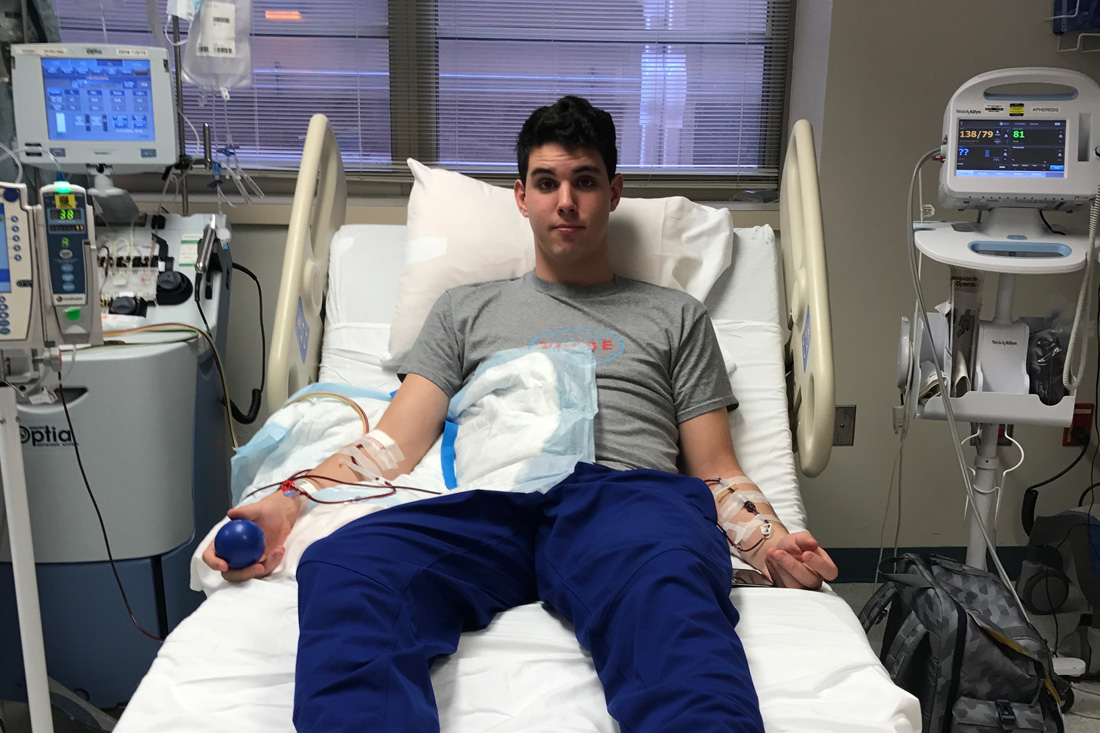7 minute read
I don’t pretend to know everything. In fact, I’ll go as far as to admit I can sometimes be a bit ignorant when it comes to some things. Even with the internet at my fingertips, I’ve found there are topics I’ve wanted to know more about, but simply hadn’t taken the time to research. This was especially true when writing my 5 Facts About Donating Bone Marrow article. Lucky for me (and my readers), I have a great partnership with Be The Match and BeTheGuy.org.
The Be The Match team has opened my eyes to just how easy it is to donate bone marrow and help potentially save someone’s life. Additionally, they were kind enough to set up an interview with Conor, a marrow donor who has gone through the entire process.
Here is what he had to say about his experience:
1. I’m sure my readers would love to get to know you a bit. Would you mind sharing your name, age, and where you live?
I’m Conor Levey, a 23-year-old living in Baltimore, MD.
2. How did you first hear about BeTheGuy.org (Be The Match) and what inspired you to join the registry?
I heard about Be The Match during the 2016 NBA Finals (so about mid-June 2016). Craig Sager, a longtime NBA reporter for TNT, was battling AML (acute myeloid leukemia), which I later learned is one of the main diseases Be The Match focuses on. Craig had never worked a Finals game, as it’s been an ABC property for a long time and he always worked for Turner. But, because of his illness, the two entities worked it out so Craig was reporting from the sidelines for Game 6. I’m a huge NBA fan and Craig Sager has been a big part of that, so when I saw online that signing up for Be The Match was a good way to help people with diseases like Craig’s, it was a no-brainer because it seemed like the least I could do.
3. After your decision to join the registry, was it easy?
Very much so. I went online, created an account, and requested a swab kit, and once it arrived a few days (maybe a couple weeks?) later, it took maybe five minutes to fill everything out and complete the process. After that, I just dropped it in the mail and I was good to go.
4. Be honest, did you Google as much as I did to learn about what it’s like to donate bone marrow?
I did some cursory research, but I really wasn’t too worried about it until I got word that I was selected for an initial blood test. That test is where a small group of people are tested in hopes of finding a good match for a patient, and if they identify you, they’ll ask you to donate. It seemed like the kind of thing where my name would be on some faraway list and I would never hear about it again, so I didn’t give it much thought. Once I was selected for the blood test part of the process, I looked a little more, and by the time I was notified that I was a match, Be The Match provided me with a wealth of material that actually gave me the full perspective. So, in short, I didn’t do much research because Be The Match told me everything I needed to know.
5. What was it like finding out you were a match?
It was, of course, a big surprise. I’d signed up in June and found out I was a match in December, which was an incredibly quick turnaround. Most people go years and years after registration without even hearing from Be The Match, and here I was identified as a match within six months. What’s crazy is I got the call about being a match the same day Craig Sager passed away, which really made it all click. I signed up in the first place because Craig was important to me and I wanted to try and help people going through what he was going through, so the symmetry, sad as it was, gave me even more motivation to do my part.
6. After you committed to donating, how long did the entire process take?
After I found out in mid-December, things moved pretty fast. I ended up donating in late January, maybe six or seven weeks later. It moved fast, but I never felt like I was being rushed into something. Be The Match makes sure you’re informed and ready every step of the way.
7. The question everyone wants to know: what was donating like; did it hurt?
Of the two donation types marrow and PBSC, the one everyone worries about is marrow. In that process, marrow is extracted from your pelvic bone, which naturally means a little more discomfort after donation, although you’re under anesthetic for the procedure itself. I donated PBSC, peripheral blood stem cells, collected by putting an IV in each arm and running my blood through a centrifuge machine. Over the days prior to my donation, I received four shots of Filgrastim, a drug that stimulates the release of stem cells from your bone marrow into your blood. Be The Match had a nurse come to my house after work to administer the shots. Filgrastim is known to make you achy, and I would say I experienced some mild discomfort now and again in the day or two before donating, but nothing at all problematic. The donation itself was very easy. They hooked me up to the centrifuge, and I just laid there for somewhere between four and five hours while the stem cells were collected. My girlfriend came to the donation with me, so we just hung out and I actually napped for a lot of it.
Long story short, I got a few shots and spent a few hours with some IVs in my arms. It was amazingly simple.
8. Do you think there is anything important to note about the “after” part of the experience?
For me, there were almost no after-effects from the donation. I didn’t have lingering aches from the Filgrastim, and other than an early bedtime after the donation, it was all systems go. Since I donated, I volunteered at a registration event to get more people signed up, and I think being able to share my story helped convince people to join. You also get check-ins every now and again from Be The Match, both making sure you’re okay and giving periodic updates on the patient you donated to.
9: Have you had the opportunity to speak with the man you donated to? If so, what was that like?
Be The Match imposes a one-year anonymity period, for patient and donor privacy. At the end of the year, I can consent to exchange contact info, and I intend to do so. If the patient does the same, contact info is released. I recently go the six-month update, and it seems like he’s responding well to the treatment, so I’m hopeful that in another six months we can talk a little bit and that he continues to improve in health!
10: Elevator pitch: what would you say to someone to convince them to join the registry if you only had a few moments to pitch them?
It’s just about the easiest opportunity you’ll ever have to maybe save a life!
This post is sponsored by Be The Match. All opinions are my own.






